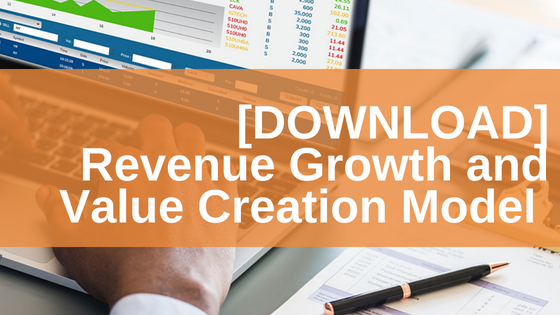Modeling Revenue Growth and Value Creation

In SaaS, how quickly and efficiently you can grow your recurring revenue directly determines your valuation.
Whether you’re selling equity in a financing round, an acquisition or an IPO, your pre-money valuation will generally be based on a multiple of your revenue run rate while taking into consideration your rate of revenue growth and your gross margin profile.
If you’re reinvesting or harvesting cash flow (distributing cash profits), the more quickly and efficiently (less cost) you can grow your revenue, the bigger the pot of money you’re building to deploy or distribute at your discretion.
In order to grow revenue, you’re going to have to spend money on customer acquisition and retention. Funding these growth efforts oftentimes requires some outside capital.
As a SaaS Founder, it’s very important to consider what all of this means in conjunction so you can understand both the requirements for and potential valuation benefits of your growth.
That’s why we’ve created a 60-Month Growth and Value Creation Model that you can utilize to plan for growth, along with instructions on how to manipulate and interpret the model.
The purpose of the model is to help Founders get a sense for:
- How their annual revenue growth goals translate into required monthly growth
- How much capital they may need to hit their customer acquisition and revenue goals
- How much value they may create by achieving their growth goals
- How much value they may retain based on the capital they raise (how much and what form).
The model is laid out in both 5 years and 60 months and has a section at the bottom to input simplified customer acquisition assumptions (ARPU/Gross Margin/CAC).
Monthly Compound Growth Requirements
Saying you’re going to grow revenue 100% year over year is one thing. Knowing that it takes growing 5.9%, on average, every month for 12 months to actually do it is what you need to accomplish.
By inputting your annual growth objectives and ARPU/CAC assumptions, you will get a sense for:
- The monthly compounded growth requirements to hit your annual revenue growth goals
- The required CAC spend to hit your annual revenue goals and
- The potential capital required to hit your revenue targets.
Simplified Valuation at Different Revenue Levels
Along with your revenue growth, comes valuation growth. The model shows your valuation step-ups along with incremental dilution taken from future capital raises and what your net equity value retention may look like as you grow with a couple of capital plans, one equity one and the other a mix of equity and debt.
A Few Notes
We have not modeled churn in, so the revenue projections are net of churn. If you have a gross revenue growth target and know your churn rate, just net your churn rate out of the growth rate you use. Also, the model does not account for your operating expenses, so we’ve 1.5x’d the required CAC to account for the total capital needed to fund your growth plan.
Here’s the link to the model. It’s view only, so just File → make a copy and play around with it.
If you have questions/thoughts, just shoot me an email at bparks@bigfootcap.com.

